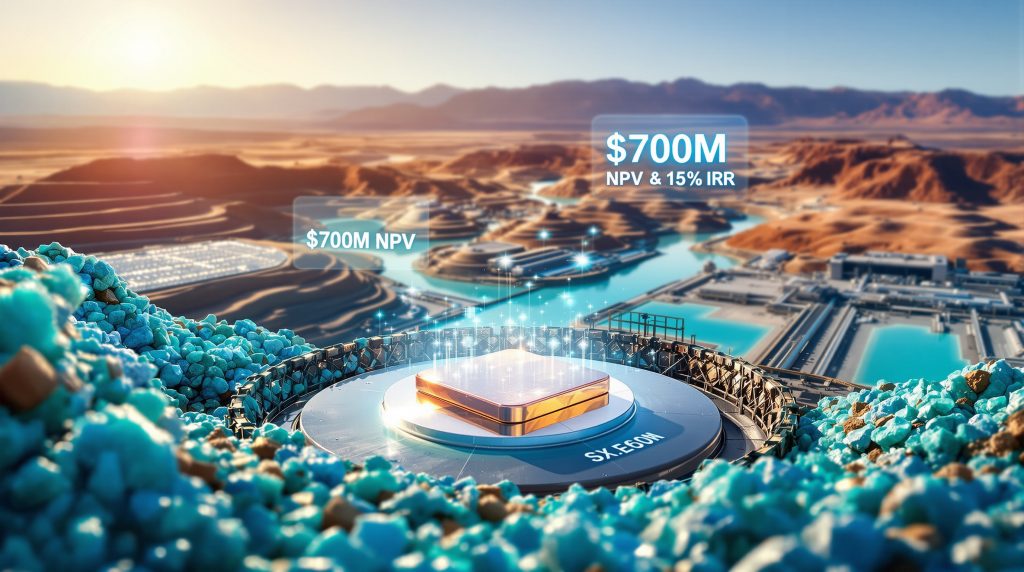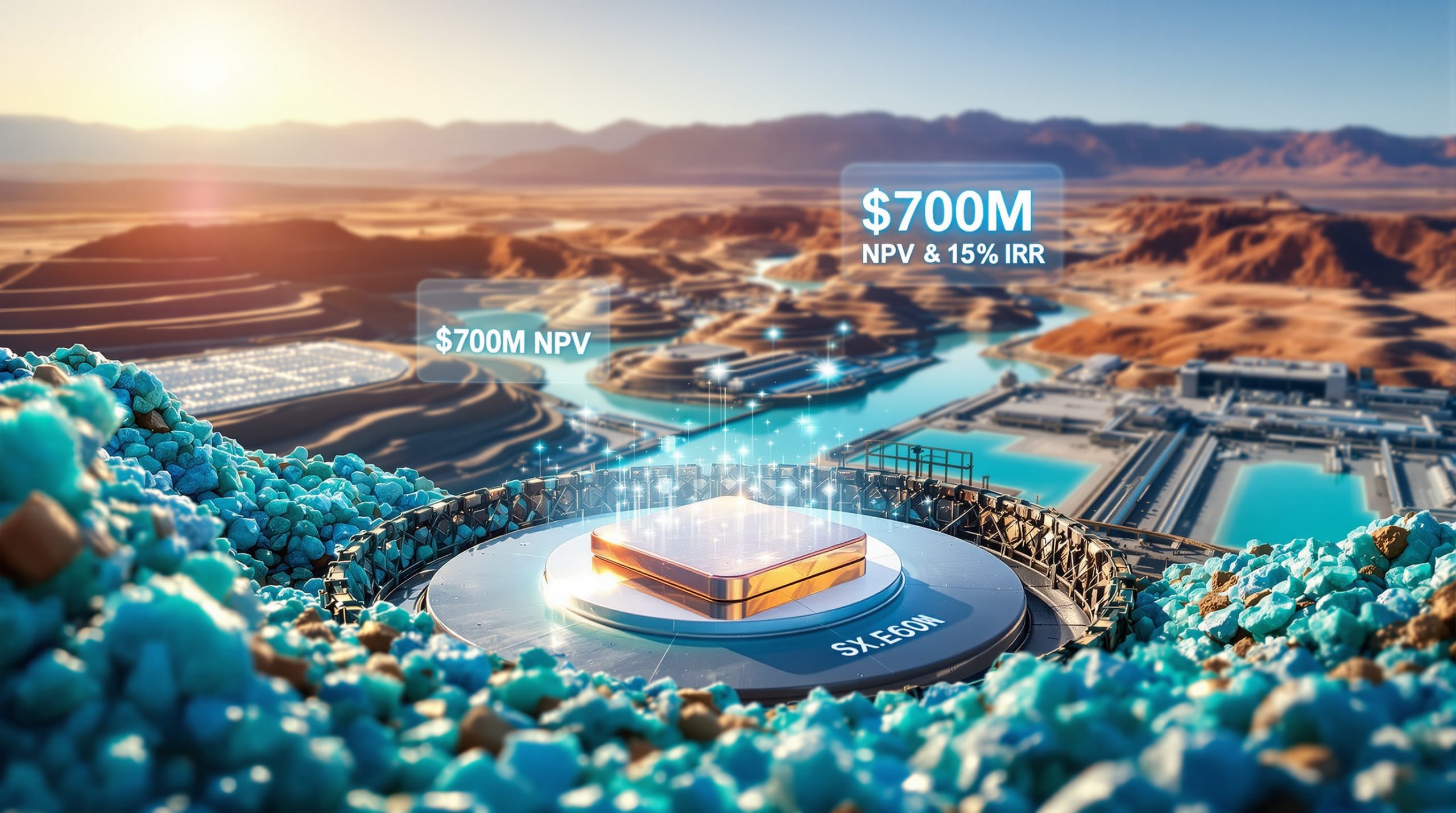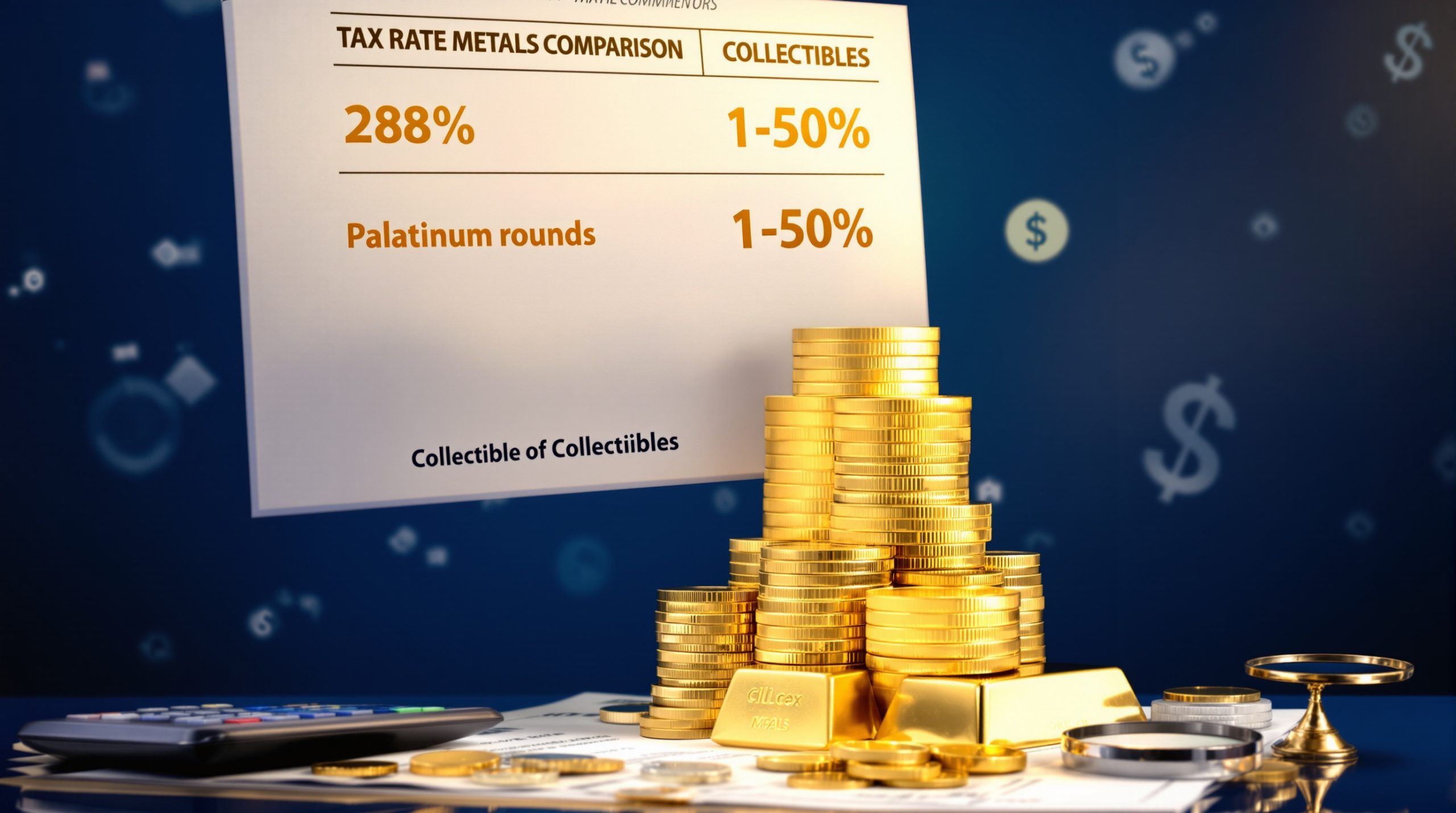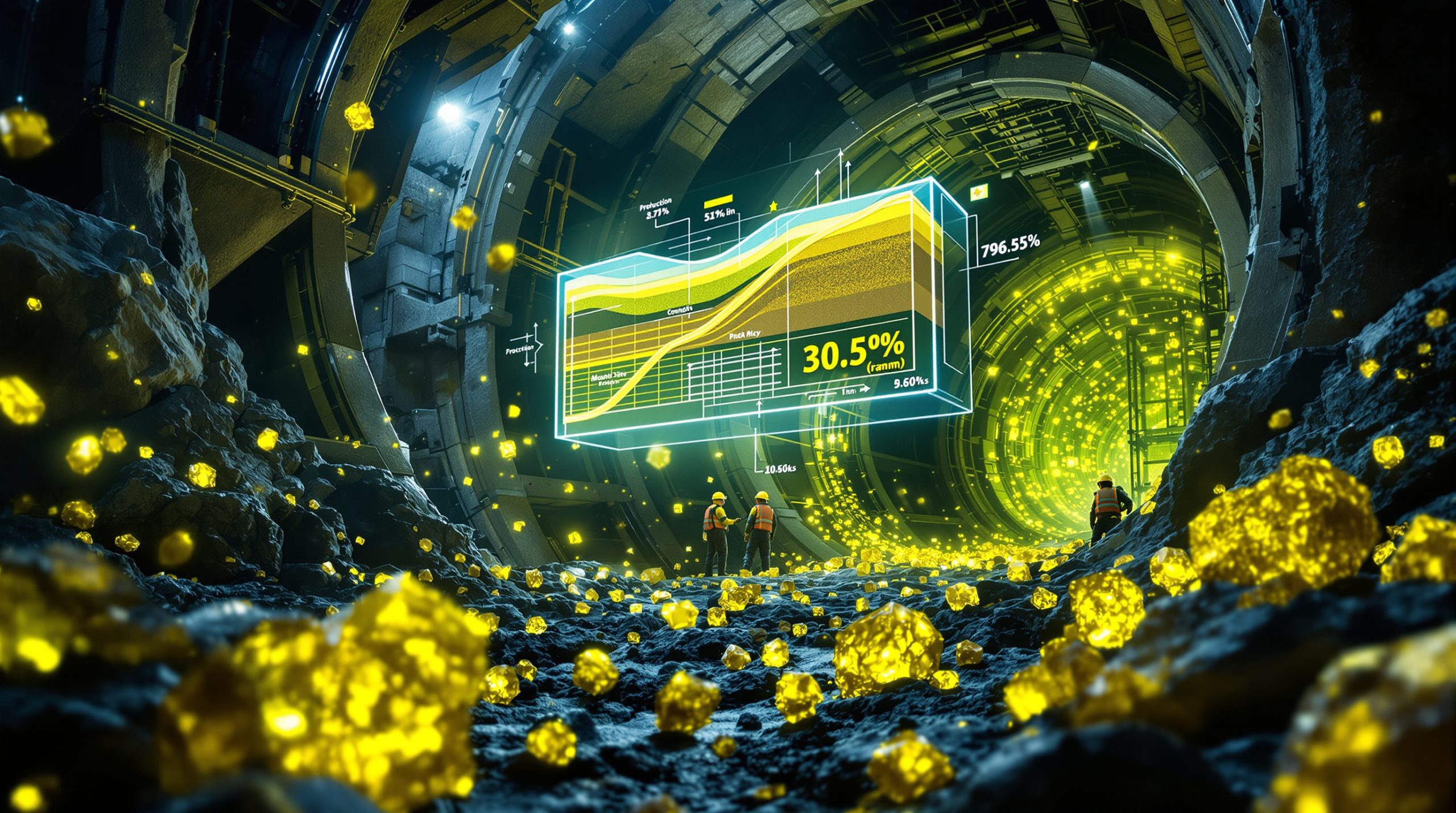What Makes Marimaca's Feasibility Study Significant for Copper Investors?
The recently released Definitive Feasibility Study (DFS) for Marimaca Copper's oxide deposit in Northern Chile confirms its position as one of the most capital-efficient copper development projects globally. With capital intensity below $12,000 per tonne of copper equivalent production, the project ranks in the bottom decile of new copper developments worldwide according to Wood Mackenzie data. This exceptional capital efficiency, combined with competitive operating costs and strong projected returns, positions Marimaca as a standout opportunity in the copper development landscape.
The project's economic profile is particularly compelling when compared against the broader industry, where rising capital costs have challenged project economics. Marimaca's ability to maintain this cost advantage stems from several factors, including its favorable location, deposit characteristics, and management's disciplined approach to development planning.
Key Economic Highlights from the Feasibility Study
The DFS presents robust financial metrics that solidify Marimaca's value proposition. Key economic highlights include:
- Post-tax NPV of $709 million at $4.30/lb copper price with 31% IRR
- Potential to exceed $1 billion NPV at higher copper price scenarios
- Pre-production capital expenditure of $587 million
- First five years C1 cash costs of $1.45/lb and AISC of $1.97/lb
- Life-of-mine C1 costs of $1.84/lb and AISC of $2.29/lb
- Operational cost structure positioned at the cusp of first and second quartile
The study demonstrates particularly strong economics during the initial production phase, with the first five years showing significantly lower operating costs than the life-of-mine average. This front-loaded value generation accelerates payback and enhances overall project returns.
How Does Marimaca's Production Profile Compare to Other Copper Developments?
The Marimaca project targets annual production of 50,000 tonnes of copper cathode, with a clear pathway to expand beyond 70,000 tonnes through the development of satellite deposits. This production scale, while at the smaller end of globally significant copper operations, represents a meaningful contribution to the market, particularly given the project's exceptional economics and growth potential.
When comparing production profiles across the copper development landscape, Marimaca occupies an interesting middle ground. It's significantly larger than many junior projects yet smaller than major mining company developments. This positioning provides a balance of scale efficiency while maintaining manageable capital requirements and execution risk.
Production Metrics and Resource Base
The DFS outlines a production profile that emphasizes consistent output with strong early performance:
- Steady-state production between years 2-10 averaging 49,000 tonnes annually
- First five years production averaging 50,000 tonnes of copper cathode
- Life-of-mine average of 43,000 tonnes over 13 years
- Maiden proven and probable mineral reserves of 178.6 million tonnes at 0.42% copper
- Total contained copper in reserves of 750,000 tonnes
- Initial recovery rates of 78% improving the overall life-of-mine recovery rate of 72%
The recovery rates, while appearing conservative compared to some comparable operations, provide a solid foundation for the economic model while offering potential upside through ongoing metallurgical optimization work.
What Engineering Advantages Does the Marimaca Project Offer?
The project benefits from several engineering advantages that contribute to its favorable economics and operational simplicity. Its location in Chile's established mining jurisdiction provides access to well-developed infrastructure and experienced workforce, while the oxide nature of the deposit enables conventional heap leach processing with lower capital requirements and operational complexity compared to traditional sulfide operations.
One significant engineering advantage is the project's location at a relatively low altitude of under 1,000 meters. Unlike many Chilean copper projects situated in the high Andes, Marimaca avoids the extreme weather conditions, challenging access, and higher construction costs associated with high-altitude development.
Technical Design Features and Optimization Opportunities
The DFS incorporates several key technical design elements that enhance project viability:
- Simple open-pit mining with a life-of-mine strip ratio of 0.8:1
- Conventional heap leach processing with SX-EW technology
- Infrastructure designed with expansion capacity for future growth
- Conservative engineering approach with significant optimization potential
- Low-altitude location (under 1,000m) avoiding high Andes design requirements
- Scalable infrastructure including crusher, conveyors, and water pipeline
The engineering team has identified multiple areas where cost optimization might be achieved during the detailed engineering phase. These include right-sizing equipment for the specific operating conditions at Marimaca rather than applying standard high-Andes specifications that add unnecessary costs and complexity.
How Is Marimaca Addressing Operational Risk Management?
Management has implemented a proactive approach to operational risk management, particularly focusing on sulfuric acid price volatility, which represents one of the most significant input cost variables. The company has secured an option to acquire a used sulfuric acid plant that would provide 30-40% of the project's base case acid requirements at a fraction of the cost of a new facility.
Sulfuric acid constitutes a major operational expense for heap leach copper operations, and price volatility can significantly impact project economics. By securing partial acid supply independence, Marimaca reduces exposure to market fluctuations while maintaining flexibility to purchase acid when market conditions are favorable.
Strategic Risk Mitigation Measures
The company's approach to risk management extends beyond conceptual planning to concrete actions:
- Option to acquire used sulfuric acid plant for $2.5 million (versus $60+ million for new)
- Plant would supply 30-40% of project acid requirements, reducing price exposure
- Technical assessment confirms viability despite plant being non-operational since 2015
- Positive NPV impact even with conservative capital cost assumptions for recommissioning
- Approach demonstrates sophisticated understanding of heap leach operational challenges
This risk management strategy provides meaningful downside protection while maintaining full upside exposure to favorable acid pricing environments. The company's willingness to invest in detailed technical assessments of the acid plant demonstrates a commitment to data-driven decision-making rather than simple cost avoidance.
What Growth Opportunities Exist Beyond the Base Case?
Marimaca's growth strategy encompasses multiple pathways to increase production from the initial 50,000 tonnes to over 70,000 tonnes annually through systematic development of satellite deposits. The infrastructure scalability built into the initial design enables cost-effective expansion integration without requiring complete facility reconstruction.
This multi-phase approach provides flexibility to respond to market conditions and operational performance, allowing for optimized capital deployment over time rather than a single massive initial investment. It also creates multiple value inflection points for investors as each development phase advances.
Expansion Pathways and Exploration Potential
Several specific growth opportunities have been identified and are being advanced:
- Pampa Medina deposit represents the most advanced growth opportunity
- Preliminary Economic Assessment for Pampa Medina nearing completion
- Madrugador oxide deposit provides additional expansion potential
- Exploration program has confirmed extensive sediment-hosted copper mineralization
- Identified mineralized area spans 1.2 kilometers east-west and 1.2 kilometers north-south
- Next exploration phase focusing on infill drilling for potential inferred resource estimate
The expansion strategy balances near-term production increase with longer-term growth opportunities. The Pampa Medina deposit, with its advanced stage of evaluation, represents a relatively low-risk expansion pathway, while continued mineral exploration trends provides exposure to potentially transformational discoveries.
What Timeline Is Marimaca Targeting for Development?
The company has outlined an ambitious but potentially achievable timeline for project development, with key milestones targeted for completion by year-end 2025. The permitting process represents the critical path item, with management expressing growing confidence in achieving the targeted timeline.
The development schedule reflects a balance between aggressive advancement and realistic timeframes for regulatory processes in Chile. While permitting remains the key variable, management has structured parallel workstreams to prevent unnecessary delays in areas that can proceed independently.
Development Milestones and Timeline
Key timeline targets include:
- Environmental Impact Assessment (RCA) approval targeted by end of 2025
- Debt financing package expected to be announced by year-end 2025
- Construction commencement targeted for Q3 2026
- Detailed engineering optimization running parallel to financing activities
- Permits will enable early site work while additional approvals secured for full construction
The timing aligns with projected copper market dynamics, with production commencement expected during a period of anticipated supply deficits. This positioning could allow Marimaca to benefit from potentially higher copper price insights during its initial production years when cash flow generation is most critical for debt service and return of capital.
How Does Marimaca Fit Within the Global Copper Market Context?
The global copper market faces a structural supply-demand imbalance that fundamentally supports higher long-term pricing and creates exceptional opportunities for quality development projects. The International Energy Agency projects copper demand will double by 2040, driven primarily by electrification and renewable energy infrastructure deployment.
Marimaca's development timeline positions it to begin production during a period when copper supply constraints are expected to become increasingly acute. The combination of declining grades at existing operations, limited new discoveries, and extended development timeframes for large-scale projects creates a favorable market environment for mid-tier producers with near-term development capabilities.
Market Dynamics and Strategic Positioning
Several macro factors enhance Marimaca's strategic positioning:
- Copper supply constraints compound demand growth from energy transition
- Major copper mines aging with declining ore grades globally
- Discovery rates for large-scale deposits have fallen dramatically
- Average lead time from discovery to production exceeds 15 years
- Geopolitical considerations increasing premium for stable jurisdictions
- Recent M&A transactions demonstrate strategic value of near-term copper projects
Chile's position as a premier copper jurisdiction provides additional advantages in terms of established infrastructure, experienced workforce, and favorable regulatory framework. While the country has experienced political changes in recent years, the fundamental support for responsible mining development remains intact, particularly for projects demonstrating strong environmental and social governance.
What Investment Considerations Apply to Marimaca Copper?
Marimaca Copper represents a compelling investment opportunity within the global copper development landscape, combining industry-leading project economics with systematic growth potential and prudent risk management. The company's DFS validates management's assertions about the project's exceptional characteristics while providing a solid foundation for the transition toward construction and production.
Investors considering Marimaca should evaluate both the standalone project economics and the company's strategic positioning within a consolidating copper sector. The scarcity of quality development projects with near-term production potential creates significant optionality value beyond simple NPV calculations.
Investment Thesis Components
The comprehensive investment case includes several key elements:
- Bottom decile capital intensity globally with 30%+ IRR at base case assumptions
- Clear path to construction start in 2026 with immediate cash flow generation
- Systematic expansion pathway to 70,000+ tonnes through satellite deposit development
- Proactive management of operational risks through acid plant acquisition option
- Northern Chile location provides political stability and established infrastructure
- Scarcity value in copper development space with recent transactions demonstrating premium valuations
- Proven leadership team with successful track record in Chilean copper development
- Development timeline aligns with anticipated global copper supply deficits
The project's exceptional capital efficiency distinguishes it from many development-stage copper opportunities. The sub-$12,000 per tonne capital intensity places Marimaca in the bottom decile globally, providing a significant advantage in securing financing and delivering strong returns even in moderate copper price environments.
How Do Recent Copper Sector M&A Transactions Inform Marimaca's Valuation?
The copper sector's M&A activity reflects the scarcity of quality development projects and the strategic value of near-term production assets. Recent transactions provide important benchmarks for evaluating Marimaca's potential value in a consolidation scenario.
Strategic buyers appear increasingly willing to pay premiums to net asset value for quality copper development projects, particularly those with near-term production potential in stable jurisdictions. This trend reflects both confidence in long-term copper fundamentals and the strategic imperative to secure future supply.
Comparable Transaction Analysis
Recent market activity provides several relevant reference points:
- Harmony Gold's acquisition of MAC Copper for over $1 billion represents a similar-scale project
- Bidding war between Kinross and Cameco for New World Resources demonstrates strong buyer interest
- Mitsubishi Corporation's transaction into Copper World suggests buyers are underwriting higher copper prices
- These transactions reflect strategic imperative to secure copper supply in constrained market
- Marimaca's combination of near-term production, growth potential, and favorable jurisdiction positioning makes it an attractive consolidation target
The valuation metrics implied by these transactions suggest potential for significant premium valuations relative to traditional discounted cash flow methodologies. Strategic buyers appear to be applying higher long-term copper price assumptions and placing additional value on scarcity, jurisdiction, and timeline considerations beyond simple project economics.
What Factors Could Impact Marimaca's Development Timeline?
While the company has outlined an ambitious development schedule, several factors could influence the actual timeline to production. Understanding these variables provides investors with a more comprehensive view of the project's risk profile and potential value realization timeframe.
Permitting represents the most significant variable in the development timeline, with Chilean regulatory processes subject to both procedural requirements and potential political considerations. While the company expresses growing confidence in the year-end 2025 target for Environmental Impact Assessment approval, this remains the critical path item for overall project advancement.
Timeline Considerations and Risk Factors
Key variables that could impact development progression include:
- Permitting process represents the critical path item with potential for delays
- Financing package complexity and market conditions could impact timing
- Detailed engineering optimization may identify opportunities for schedule improvement
- Construction contractor availability in Chile's active mining sector
- Supply chain considerations for major equipment procurement
- Weather conditions and seasonal factors affecting construction activities
- Potential for accelerated timeline through early works program if permits secured
Management's approach to timeline risk includes structuring parallel workstreams where possible and maintaining flexibility to accelerate activities when opportunities arise. The company's focus on detailed engineering optimization during the permitting phase demonstrates a commitment to maximizing schedule efficiency rather than sequential advancement.
How Does Marimaca's Approach to ESG and Community Relations Support Project Development?
In today's mining environment, environmental, social, and governance (ESG) considerations play an increasingly important role in project development success. Marimaca's approach to these factors represents a significant component of its overall development strategy.
The company has integrated ESG considerations from the project's earliest design phases rather than treating them as compliance requirements or afterthoughts. This approach aligns with evolving stakeholder expectations while potentially streamlining permitting and reducing operational risks.
ESG Strategy and Implementation
Key elements of Marimaca's ESG approach include:
- Water management strategy utilizing seawater without competing with community resources
- Energy efficiency measures incorporated into project design
- Community engagement programs established early in development process
- Local employment and procurement policies to maximize regional economic benefits
- Rehabilitation and closure planning integrated from project inception
- Governance structure emphasizing transparency and stakeholder communication
- Environmental design focused on minimizing footprint and impact
The seawater utilization strategy represents a particularly important component of the ESG approach in Chile's water-stressed Atacama region. By avoiding competition with community water resources, Marimaca reduces both regulatory risks and potential community concerns while securing operational water independence.
FAQ: Marimaca Copper Feasibility Study
What is the expected payback period for the Marimaca project?
Based on the feasibility study results, the project has a payback period of approximately 2.9 years at the base case copper price of $4.30/lb, demonstrating the rapid capital recovery potential of the operation.
How does the project's water supply strategy address sustainability concerns?
The project will utilize seawater through a dedicated pipeline system, avoiding competition with local communities for scarce freshwater resources in Chile's Atacama region.
What power infrastructure will support the operation?
The project will connect to Chile's national grid, benefiting from the country's increasing renewable energy mix, with power costs estimated at 9 cents/kWh all-in.
How does the mine plan optimize the resource extraction?
The mine plan employs a phased approach that targets higher-grade material in early years while maintaining a low strip ratio of 0.8:1 over the life of mine, optimizing both capital efficiency and operational costs.
What processing technology will be used at Marimaca?
The project will utilize conventional heap leach processing with solvent extraction and electrowinning (SX-EW) technology, a well-established method for oxide copper ores that produces copper cathode directly at the mine site.
Further Exploration:
Readers interested in learning more about copper project development in Chile can also explore related educational content from industry sources covering mining feasibility studies, copper investment strategies, and Codelco copper strategy in South America.
Searching for Investment Opportunities in the Next Mineral Discovery?
Discovery Alert's proprietary Discovery IQ model delivers real-time notifications on significant ASX mineral discoveries, empowering subscribers to identify actionable trading opportunities ahead of the broader market. Discover why major mineral discoveries can lead to substantial returns by exploring Discovery Alert's dedicated discoveries page.




